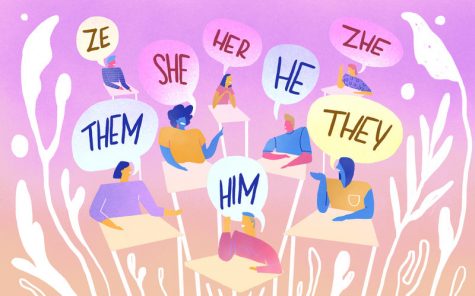Appearance Does Not Reveal Gender: Normalizing The Use Of Pronouns
January 27, 2020
 New gender identities and expressions have been more prevalent in society during the last years, moving away from the stereotypical “male,” and “female,” or “his” and “her,” as the standard. Now, members of society are moving towards making all pronouns gender neutral so that everybody is taken into consideration and approached with their desired pronouns.
New gender identities and expressions have been more prevalent in society during the last years, moving away from the stereotypical “male,” and “female,” or “his” and “her,” as the standard. Now, members of society are moving towards making all pronouns gender neutral so that everybody is taken into consideration and approached with their desired pronouns.
“We can never tell, by looking at someone, what their gender identity is,” Nicole McCarter, the university assistant at the LGBT center, said. “We all have pronouns, not only people who are trans.”
The LGBT Center organized the Pronoun Etiquette Campaign to raise awareness and normalize the usage of pronouns, so that it becomes an everyday thing and trans people and allies feel comfortable consistently using them.
McCarter said that one of the main pillars to normalize the use of pronouns is educating society on the differences between gender identity and gender expression. Gender identity is how a person feels and sees themselves as, which may not correspond with their biological sex. Gender expression is how a person shows their gender identity, through their physical appearance, clothing and behavior.
For instance, someone wearing a dress does not necessarily go by the pronouns “she, her, hers” and someone with a beard does not always identify with “he, him, his.”
“A few semesters ago, I was put together on a group project with a girl that asked me what my pronouns were,” Myles Place, a student worker at the LGBT Center, said. “’I don’t want to offend you,’ she said, but I thought it was the best thing on the planet to do.”
Trans people and people in general typically feel grateful when someone asks them for their pronouns. Therefore, as McCarter said, it is important to start those conversations and get rid of the awkwardness, as well as to give out little guides that can help to create a safe space to ask any kind of question.
The LGBT Center’s tabling in Student Center was organized in hopes to answer questions, as well as hand out etiquette guides and pronoun button pins with statements like “Ask Me My Pronouns,” ,“He Him His,”,“First Name Only,”, “She Her Hers” and “Them Their Theirs.”
Place said that, to make things clear and normalize pronouns, he usually wears a button on him with his pronouns. He also explained that including a persons’ pronouns on the bottom of their email or on their social media bio are casual ways to pave the path to normalization as well.
Another way to open the door to this conversation is to introduce oneself with one’s pronouns. “I’m trying to challenge myself to start every situation as ‘Hi, my name is Nicole and my pronouns are ‘She, Her, Hers” how about you?’And it is okay if they choose not to respond, it takes a bit to get used to,” McCarter said.
The subtle detail has become a bit more common, as more and more professors are starting to ask students for their names and pronouns the first day of class, so that even if somebody does not feel comfortable saying what they really go by in that space, they know that the professor is thinking about that and taking it into consideration.
The LGBT Center has a Preferred First Name Program that offers transitioning and non-transitioning students the possibility to change their real name for their chosen name on all university records that are not legal. For instance, the name would appear on course rosters, ID cards, email directories and university’s websites, among others.
The LGBT Center also provides trainings and facilitates workshops for departments and groups for request. They can be found in the Student Center in rooms 304-305, or contacted at (860) 832-2090 and [email protected].



